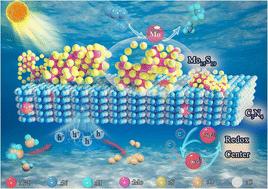当前位置:
X-MOL 学术
›
Inorg. Chem. Front.
›
论文详情
Our official English website, www.x-mol.net, welcomes your
feedback! (Note: you will need to create a separate account there.)
Multistage construction of Gd-doped g-C3N4/Mo15S19 composites enabled both N2 activation and multiple electron transfer for an enhanced photocatalytic nitrogen reduction reaction
Inorganic Chemistry Frontiers ( IF 6.1 ) Pub Date : 2024-11-04 , DOI: 10.1039/d4qi02016b Xiaoyu Jiang, Boran Tao, Hongda Li
Inorganic Chemistry Frontiers ( IF 6.1 ) Pub Date : 2024-11-04 , DOI: 10.1039/d4qi02016b Xiaoyu Jiang, Boran Tao, Hongda Li

|
The efficiency of photocatalytic nitrogen reduction reactions (NRRs) faces significant challenges due to the need for effective activation of the N![[triple bond, length as m-dash]](https://www.rsc.org/images/entities/char_e002.gif) N bond and efficient multi-electron/proton transfer. A novel Gd-doped and Mo15S19-loaded g-C3N4 nanorod (GdC3N4/Mo15S19) is promoted in this work. The experimental results show that the GdC3N4/Mo15S19 composite exhibits remarkable visible-light-driven photocatalytic ammonia production (407.51 μmol g−1 h−1, 33 times that of g-C3N4), which is attributed to the promoted multiple electron transfer by in-built Gd3+ redox centers and increased Mo active sites by loading of Mo15S19. Calculations using Density Functional Theory (DFT) show that Mo15S19 loading also helps to effectively activate the N
N bond and efficient multi-electron/proton transfer. A novel Gd-doped and Mo15S19-loaded g-C3N4 nanorod (GdC3N4/Mo15S19) is promoted in this work. The experimental results show that the GdC3N4/Mo15S19 composite exhibits remarkable visible-light-driven photocatalytic ammonia production (407.51 μmol g−1 h−1, 33 times that of g-C3N4), which is attributed to the promoted multiple electron transfer by in-built Gd3+ redox centers and increased Mo active sites by loading of Mo15S19. Calculations using Density Functional Theory (DFT) show that Mo15S19 loading also helps to effectively activate the N![[triple bond, length as m-dash]](https://www.rsc.org/images/entities/char_e002.gif) N bond, which accelerates the NRR's start. The synergistic effect of Gd doping and Mo15S19 loading lowers the Gibbs free energy of intermediates, enhancing the overall photocatalytic efficiency. This work provides a viable approach to the construction of multistage structures in the photocatalytic NRR that incorporates multiple electron transfer and N2 activation effects.
N bond, which accelerates the NRR's start. The synergistic effect of Gd doping and Mo15S19 loading lowers the Gibbs free energy of intermediates, enhancing the overall photocatalytic efficiency. This work provides a viable approach to the construction of multistage structures in the photocatalytic NRR that incorporates multiple electron transfer and N2 activation effects.
中文翻译:

Gd 掺杂 g-C3N4/Mo15S19 复合材料的多级构建实现了 N2 活化和多电子转移,从而增强了光催化氮还原反应
由于需要有效激活 N![[triple bond, length as m-dash]](https://www.rsc.org/images/entities/char_e002.gif) N 键和高效的多电子/质子转移,光催化氮还原反应 (NRR) 的效率面临重大挑战。这项工作推广了一种新型的 Gd 掺杂和 Mo15S19 负载的 g-C3N4 纳米棒 (GdC3N4/Mo15S19)。实验结果表明,GdC3N4/Mo15S19 复合材料表现出显著的可见光驱动光催化氨产生 (407.51 μmol g-1 h-1,是 g-C3N4 的 33 倍),这归因于内置 Gd 促进了多电子转移通过加载 Mo15S19 获得 3+ 氧化还原中心和增加的 Mo 活性位点。使用密度泛函理论 (DFT) 的计算表明,Mo15S19 负载也有助于有效激活 N
N 键和高效的多电子/质子转移,光催化氮还原反应 (NRR) 的效率面临重大挑战。这项工作推广了一种新型的 Gd 掺杂和 Mo15S19 负载的 g-C3N4 纳米棒 (GdC3N4/Mo15S19)。实验结果表明,GdC3N4/Mo15S19 复合材料表现出显著的可见光驱动光催化氨产生 (407.51 μmol g-1 h-1,是 g-C3N4 的 33 倍),这归因于内置 Gd 促进了多电子转移通过加载 Mo15S19 获得 3+ 氧化还原中心和增加的 Mo 活性位点。使用密度泛函理论 (DFT) 的计算表明,Mo15S19 负载也有助于有效激活 N ![[triple bond, length as m-dash]](https://www.rsc.org/images/entities/char_e002.gif) N 键,从而加速 NRR 的启动。Gd 掺杂和 Mo15S19 负载的协同作用降低了中间体的吉布斯自由能,提高了整体光催化效率。这项工作为在光催化 NRR 中构建多级结构提供了一种可行的方法,该方法结合了多电子转移和 N2 活化效应。
N 键,从而加速 NRR 的启动。Gd 掺杂和 Mo15S19 负载的协同作用降低了中间体的吉布斯自由能,提高了整体光催化效率。这项工作为在光催化 NRR 中构建多级结构提供了一种可行的方法,该方法结合了多电子转移和 N2 活化效应。
更新日期:2024-11-08
![[triple bond, length as m-dash]](https://www.rsc.org/images/entities/char_e002.gif) N bond and efficient multi-electron/proton transfer. A novel Gd-doped and Mo15S19-loaded g-C3N4 nanorod (GdC3N4/Mo15S19) is promoted in this work. The experimental results show that the GdC3N4/Mo15S19 composite exhibits remarkable visible-light-driven photocatalytic ammonia production (407.51 μmol g−1 h−1, 33 times that of g-C3N4), which is attributed to the promoted multiple electron transfer by in-built Gd3+ redox centers and increased Mo active sites by loading of Mo15S19. Calculations using Density Functional Theory (DFT) show that Mo15S19 loading also helps to effectively activate the N
N bond and efficient multi-electron/proton transfer. A novel Gd-doped and Mo15S19-loaded g-C3N4 nanorod (GdC3N4/Mo15S19) is promoted in this work. The experimental results show that the GdC3N4/Mo15S19 composite exhibits remarkable visible-light-driven photocatalytic ammonia production (407.51 μmol g−1 h−1, 33 times that of g-C3N4), which is attributed to the promoted multiple electron transfer by in-built Gd3+ redox centers and increased Mo active sites by loading of Mo15S19. Calculations using Density Functional Theory (DFT) show that Mo15S19 loading also helps to effectively activate the N![[triple bond, length as m-dash]](https://www.rsc.org/images/entities/char_e002.gif) N bond, which accelerates the NRR's start. The synergistic effect of Gd doping and Mo15S19 loading lowers the Gibbs free energy of intermediates, enhancing the overall photocatalytic efficiency. This work provides a viable approach to the construction of multistage structures in the photocatalytic NRR that incorporates multiple electron transfer and N2 activation effects.
N bond, which accelerates the NRR's start. The synergistic effect of Gd doping and Mo15S19 loading lowers the Gibbs free energy of intermediates, enhancing the overall photocatalytic efficiency. This work provides a viable approach to the construction of multistage structures in the photocatalytic NRR that incorporates multiple electron transfer and N2 activation effects.
中文翻译:

Gd 掺杂 g-C3N4/Mo15S19 复合材料的多级构建实现了 N2 活化和多电子转移,从而增强了光催化氮还原反应
由于需要有效激活 N


















































 京公网安备 11010802027423号
京公网安备 11010802027423号